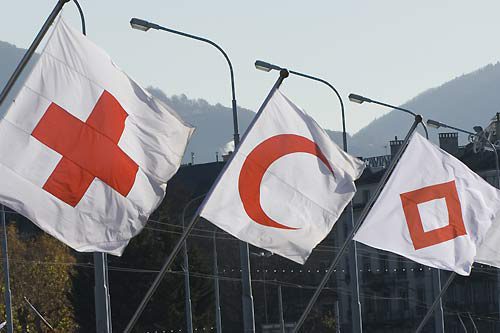Global Issues
An Overview Of The Role Of Information And Communications Technology In International Humanitarian Law -By Oyetola Muyiwa Atoyebi & Joannah Titus
Human rights advocates also have novel options to record human rights abuses during armed conflict in today’s digital age. Their work heavily relies on digital tools to enhance fact-finding operations. These works are further made available to the public for access via the internet.

International Humanitarian Law has been impacted by information and communications technology (ICT), as have most other fields. ICT advancements have led to the creation of new weapons of war that are utilized in violent conflicts. ICT has a big impact on how conflicts are currently conducted, including enemy detection, weapon programming, monitoring, etc. Technology improvements have led to the emergence of new types of warfare, including cyber-attacks, armed drones, and robotics, which present significant humanitarian and legal issues. Before developing or purchasing a new weapon, instrument, or tactic of combat, a state must ascertain if it accords with international humanitarian law. However, when those laws are put into practice, it may be questioned whether they are sufficiently explicit in light of the distinctive characteristics and anticipated humanitarian effects of a new technology.
INTRODUCTION
The area of law known as International Humanitarian Law (IHL)is the law that seeks to protect civilians who are victims of armed conflicts and war. What this law does is distinguish between civilians and combatants and prescribe punishment for offenders. International humanitarian law is a set of rules which seek for humanitarian reasons, to limit the effects of armed conflicts. It protects persons who are no longer participating in the hostilities and restricts the means and methods of warfare.
Information and Communication Technology (ICT) has affected most fields including that of IHL. ICT influences IHL hence, a relationship is formed. Through developments in ICT, new weapons of warfare have been made and are used for armed conflicts. ICT is contributing significantly to the way wars are now fought – detection of enemies, programming of military weapons, surveillance, et cetera.
This article seeks to broadly discuss International Humanitarian Law (IHL) and relate it to the recent innovations in Information and Communication Technology. It poses answers to the following questions: How has technology been able to influence IHL? What is the position of ICT in IHL? How does ICT affect armed conflicts and other incidental issues?
It would not be strange to say that the term ‘International Humanitarian Law’ may seem quite enigmatic prima facie to our Nigerian Jurisprudence, but we hope to use this work to analyze this aspect of law with the relatable field of Information Technology.
WHAT IS INFORMATION AND COMMUNICATIONS TECHNOLOGY?
Information and Communications Technology is a diverse set of technological tools and resources used to transmit, store, create, share, or exchange information. These technological tools and resources include; computers, the internet (websites, blogs and emails), live broadcasting technologies (podcasting, audio and video players and storage devices) and telephony (fixed or mobile, satellite, Visio/visual-conferencing, etc.)[1]. It is the electronic medium of sending, creating, storing, manipulating and receiving information. Some recent innovations of ICT are 5G, Artificial Intelligence, Augmented Reality(AR) and Visual Reality (VR), Internet of Things.[2]
HOW ICT AIDS THE IMPLEMENTATION OF IHL
The manner of communication between and among military groups has been improved by the availability of smartphones, smartwatches, and other ICT gadgets. This use has improved the communication flexibility internally among military groups too. The development of international humanitarian law has been made possible by these same nascent technologies.
With access to smartphones, more people can easily read on any area of IHL. Also, they can follow trends of war and get updates on conflict regions. To an extent, this has put away the need for television because virtually, everyone now has a television on their smartphones. People get updates via social platforms like Twitter, Facebook, et cetera; this has enabled people to contribute opinions to current war situations via the comment system on these online platforms.
“Mass communication”, a function that had hitherto been mostly reserved for States, has now become affordable, simple, and effective for organized armed organizations. For instance, over the previous few years, few people could have missed ISIS recruitment and propaganda videos on social media sites[3]. The influence of ICT on IHL can be exemplified by this scenario:
A warring group wants to reclaim a town that is being besieged. The party plans to undertake an influence campaign via various social media platforms prior to starting the main actions in order to get residents to divulge information about the whereabouts, stature, and equipment of the enemy. It is highly recommended that submissions of images be made, especially of films, and locals may even get financial compensation for doing so.
ICT, exemplified by platforms such as GoFundMe, FundRazr, and Patreon, has enabled people not affected during armed conflicts to contribute monetarily to NGOs that are taking care of those affected by armed conflicts. The money contributed has gone a long way in aiding the availability of food, water, and other necessary amenities for survival. ICT, exemplified by platforms like change.org, has made it easier for people to contribute to the stopping of an act or passing of a policy by a State, through its petition signing feature. People can now put their signatures on petitions commanding a State to do or abstain from doing a thing. ICT is consequently more crucial than ever, since it gives guardians the tools they need to prevent internet interruption, hacking, cyberbullying, or even danger.[4]
Human rights advocates also have novel options to record human rights abuses during armed conflict in today’s digital age. Their work heavily relies on digital tools to enhance fact-finding operations. These works are further made available to the public for access via the internet.
RESTRICTIONS PLACED ON ICTINNOVATIONS IN IHL
It is no doubt that IHL has various laws that regulate its operations. Some of these laws have undoubtedly restricted some of the innovations of ICT which could be applied during times of armed conflicts. They include;
Convention on Certain Conventional Weapons (CCW or CCWC) – This, which was reached in Geneva on October 10, 1980, and which came into effect in December 1983, aims to forbid or restrict the use of some conventional weapons that are deemed to cause disproportionate harm or have indiscriminate effects.
Chemical Weapons Convention (CWC) – This treaty was entered into force on 29th April 1997, and forbids the creation, manufacture, stockpiling, transfer, and large-scale deployment of chemical weapons and their precursors, save for extremely specific objectives (research, medical, pharmaceutical or protective). The convention’s primary requirement for member states is to implement this prohibition and the eradication of all chemical weapons in use today. Every act of destruction must be verified by the Organisation for the Prohibition of Chemical Weapons. The convention includes provisions for routine inspections of chemical manufacturing sites, and for looking into claims of the use and manufacture of chemical weapons based on information from other state parties.
The principle of precaution in attack[5] – This principle is a customary one in armed conflicts which posits that where there are more than two approaches available to attack a military objective, the less harmful approach should be utilized. In respect of ICT, where its utilization will be more disastrous it should not be used.
THE COMPLEXITIES AND THE EFFECTSOF ICT IN INTERNATIONAL HUMANITARIAN LAW
New forms of warfare, including cyber-attacks, armed drones, and robotics, have emerged as a result of technological advancements, posing new humanitarian and legal problems. It is crucial that a state determines whether a new weapon, tool, or tactic of conflict complies with international humanitarian law before creating or acquiring it. However, the question of whether already-existing legal regulations are sufficiently explicit in light of the unique features, and anticipated humanitarian consequences of a new technology may arise when those regulations are applied.
Today, all states recognize that the use of ICTs in future conflicts between states is becoming more likely[6]. In fact, the use of ICTs in armed conflicts has been a reality for several years, posing a real risk of harm to civilians, civilian infrastructure and societies.
The proliferation of military robots, in particular, the targeted killing operations carried out by drones and the use of cyber-weapons, allow the multiplication of more or less hostile operations of the states without the deployment of military forces on the ground. If the bombing of the villa of a terrorist leader in a country by a drone, or the use of a virus against industrial installations in another country may be considered an unlawful unfriendly act, the question is whether this act can bring an armed conflict into existence.
Through ICT, without human interference, autonomous weapon systems choose and strike targets. An autonomous weapon system self-initiates or triggers a strike in response to information from the environment obtained through sensors, and on the basis of a generalized “target profile” after being initially activated or launched by a person. This implies that the user has no control over, and may not even be aware of, the precise target(s), time, and/or location of the ensuing application(s) of force.[7]
This new generation of weapons, taking advantage of computer advances allow on the one hand, a geographical and therefore physical distance between the target and the military personnel using the weapon, and on the other hand, the means to gradually exclude man from the process of their use. The development of new weapon technologies, such as cyber warfare, military robotization, and particularly autonomous weapons, has raised fundamental concerns about the future application of international humanitarian law (IHL) on the battlefields, despite the fact that weapon technology innovation is as old as warfare itself.
Cyber-attacks and their consequences are on top of the agenda around the world. Apart from causing substantial economic loss, cyber operations can cause physical damage and affect the delivery of essential services to civilians.[8]Its usage as a means or method of warfare offers militaries the possibility of achieving their objectives without necessarily causing direct harm to civilians or physical damage to civilian infrastructure.
Depending on the circumstance, cyber operations might enable targeting a military objective while reducing the expected incidental damage to civilian objects compared to the use of other means of warfare.[9] There is a real risk that cyber tools – either deliberately or by mistake – may cause large-scale and diverse effects on critical civilian infrastructure. The interconnectedness of cyberspace also means that all States should be concerned with its effective regulation: “attacks carried out against one State can affect many others – wherever they are located and irrespective of whether they are involved in the conflict”. [10]
Scholars and experts have also found that cyber-attacks or operations during armed conflict may affect the delivery of health care, industrial control systems, or the reliability or availability of core internet services which serves as essential services to civilians.[11]
CONCLUSION
IHL can control current disputes since its tenets are flexible enough to meet changing needs. The influence of legal distortions caused by ideological interpretations poses a true threat to the law of armed conflict. IHL is therefore still relevant. It is a useful framework as long as it is put into practice. The issues raised in this article show that the problem is more with the use and interpretation of the legal framework of IHL, than with its applicability to the existence of a true international community.
It is recommended that more laws be made to cover newer technologies not covered by the laws of armed conflict. ICT weapons have become more advanced and specific, such as robots programmed to kill targets based on configured code input[12].
AUTHOR: Oyetola Muyiwa Atoyebi, SAN, FCIArb. (UK).
Mr. Oyetola Muyiwa Atoyebi, SAN is the Managing Partner of O. M. Atoyebi, S.A.N & Partners (OMAPLEX Law Firm) where he also doubles as the Team Lead of the Firm’s Emerging Areas of Law Practice.
Mr. Atoyebi has expertise in and a vast knowledge of Technology, Media and Telecommunications Law and this has seen him advise and represent his vast clientele in a myriad of high level transactions. He holds the honour of being the youngest lawyer in Nigeria’s history to be conferred with the rank of a Senior Advocate of Nigeria.
He can be reached at atoyebi@omaplex.com.ng
CONTRIBUTOR: Joannah Titus.
Joannah is a member of the Dispute Resolution Team at OMAPLEX Law Firm. She also holds commendable legal expertise in International Humanitarian Law.
She can be reached at joannah.emmanuel@omaplex.com.ng.
[1]Learning Portal, “Information and communication technologies (ICT)” (2017) <https://learningportal.iiep.unesco.org/en/glossary/information-and-communication-technologies-ict> accessed 22nd August 2022
[2]Finerton Holding, “The top ICT innovations for 2019” (21 November 2019), <https://learningportal.iiep.unesco.org/en/glossary/information-and-communication-technologies-ict> accessed 22nd August 2022
[3] Pontus Winther, “Military Influence Operations & IHL: Implications of New Technologies”, Relief Web, (27 Oct 2017) <https://reliefweb.int/report/world/military-influence-operations-ihl-implications-new-technologies> accessed 21st August 2022
[4] OSCE, “Preventing violations of international humanitarian law and protecting civilians require closer cooperation, OSCE leaders say”, (28 March 2022) <https://www.osce.org/odihr/514789> accessed 21st August 2022
[5] Weapons Law Encyclopedia, “Precautions in attacks (under IHL)”, <http://www.weaponslaw.org/glossary/precautions-in-attacks-ihl#:~:text=The%20international%20humanitarian%20law%20rule,for%20the%20choice%20of%20weapons.> accessed 21st August 2022
[6] ICRC, ‘The use of ICTs in armed conflicts poses a real risk of harm to civilians and civilian infrastructure <https://www.icrc.org/en/document/icts-armed-conflicts-risk-harm-civilians-civilian-infrastructure> accessed August 23, 2022.
[7] ICRC, “ICRC position on autonomous weapon systems”, (12th May 2021) <https://www.icrc.org/en/document/icrc-position-autonomous-weapon-systems> accessed 21st August 2022
[8] ICRC, The potential human cost of cyber operations, (2019), <https://blogs.icrc.org/law-and-policy/2019/05/29/potential-human-costs-cyber-operations-key-icrc-takeaways-discussion-tech-experts/> accessed August 21, 2022
[9] Laurent Gisel and TilmanRodenhauser and Knut Dormann, Twenty years on: International humanitarian law and the protection of civilians against the effects of cyber operations during armed conflicts, International Review of the Red Cross (2020), 102 (913), 287–334. Digital technologies and war doi:10.1017/S1816383120000387
[10] Helen Durham, “Cyber Operations during Armed Conflict: 7 Essential Law and Policy Questions”, Humanitarian Law and Policy Blog, (2020), <https://blogs.icrc.org/law-and-policy/2020/03/26/cyber-armed-conflict-7-law-policy-questions/>accessed August 21, 2022
[11] ICRC, The Potential Human Cost of Cyber Operations, Expert Meeting 14-16 November, (Geneva, 2018), <https://www.icrc.org/en/download/file/97346/the-potential-human-cost-of-cyber-operations.pdf> accessed August 21, 2022
[12] Eric Pomès, “Technological Innovations and International Humanitarian Law: Challenges and Tensions”, Polish Political Science Yearbook vol. 46 (2) (2017), 218




















